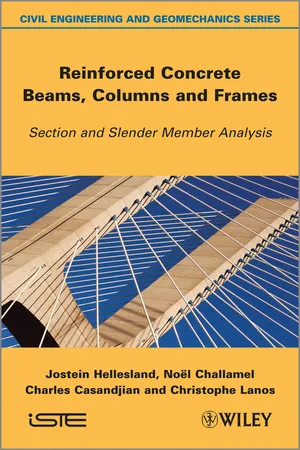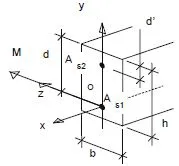
Reinforced Concrete Beams, Columns and Frames
Section and Slender Member Analysis
- English
- ePUB (mobile friendly)
- Available on iOS & Android
Reinforced Concrete Beams, Columns and Frames
Section and Slender Member Analysis
About This Book
This book is focused on the theoretical and practical design of reinforced concrete beams, columns and frame structures. It is based on an analytical approach of designing normal reinforced concrete structural elements that are compatible with most international design rules, including for instance the European design rules – Eurocode 2 – for reinforced concrete structures. The book tries to distinguish between what belongs to the structural design philosophy of such structural elements (related to strength of materials arguments) and what belongs to the design rule aspects associated with specific characteristic data (for the material or loading parameters). A previous book, entitled Reinforced Concrete Beams, Columns and Frames – Mechanics and Design, deals with the fundamental aspects of the mechanics and design of reinforced concrete in general, both related to the Serviceability Limit State (SLS) and the Ultimate Limit State (ULS), whereas the current book deals with more advanced ULS aspects, along with instability and second-order analysis aspects. Some recent research results including the use of non-local mechanics are also presented. This book is aimed at Masters-level students, engineers, researchers and teachers in the field of reinforced concrete design. Most of the books in this area are very practical or code-oriented, whereas this book is more theoretically based, using rigorous mathematics and mechanics tools.
Contents
1. Advanced Design at Ultimate Limit State (ULS).
2. Slender Compression Members – Mechanics and Design.
3. Approximate Analysis Methods.
Appendix 1. Cardano's Method.
Appendix 2. Steel Reinforcement Table.
About the Authors
Jostein Hellesland has been Professor of Structural Mechanics at the University of Oslo, Norway since January 1988. His contribution to the field of stability has been recognized and magnified by many high-quality papers in famous international journals such as Engineering Structures, Thin-Walled Structures, Journal of Constructional Steel Research and Journal of Structural Engineering.
Noël Challamel is Professor in Civil Engineering at UBS, University of South Brittany in France and chairman of the EMI-ASCE Stability committee. His contributions mainly concern the dynamics, stability and inelastic behavior of structural components, with special emphasis on Continuum Damage Mechanics (more than 70 publications in International peer-reviewed journals).
Charles Casandjian was formerly Associate Professor at INSA (French National Institute of Applied Sciences), Rennes, France and the chairman of the course on reinforced concrete design. He has published work on the mechanics of concrete and is also involved in creating a web experience for teaching reinforced concrete design – BA-CORTEX.
Christophe Lanos is Professor in Civil Engineering at the University of Rennes 1 in France. He has mainly published work on the mechanics of concrete, as well as other related subjects. He is also involved in creating a web experience for teaching reinforced concrete design – BA-CORTEX.
Frequently asked questions
Information
Chapter 1
Advanced Design at Ultimate Limit State (ULS)
1.1. Design at ULS – simplified analysis
1.1.1. Simplified rectangular behavior – rectangular cross-section
1.1.1.1. Simplified rectangular behavior – rectangular cross-section with only tensile steel reinforcement














Table of contents
- Cover
- Contents
- Title page
- Copyright page
- Preface
- Chapter 1: Advanced Design at Ultimate Limit State (ULS)
- Chapter 2: Slender Compression Members – Mechanics and Design
- Chapter 3: Approximate Analysis Methods
- Appendix 1: Cardano’s Method
- Appendix 2: Steel Reinforcement Table
- Bibliography
- Index